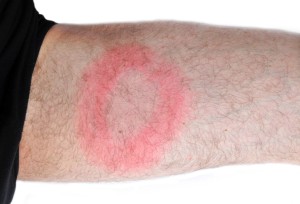Introduction
Lyme disease is transmitted through ticks that are infected with the lime disease spirochete, Borrelia burgdorferi (thanks to hardinmd.lib.uiowa.edu for image).
It might not be seen that often in the general public, but if it is overlooked, it is devastating. The name comes from a town, Lyme / Connecticut. In the mid 1970’s there was a cluster of cases that occurred in that region and ever since the disease was found to follow the infected tick population that is often carried by deer. Most cases in the U.S. are found between Massachusetts and Maryland.
Symptoms
After the bite of a tick there is a rash in the majority of cases (but not always!) that develops within the course of 3 days to 1 month. This is like a ring that grows from the center of the bite to the periphery. At one point it might look like a “bull’s eye”, thus dermatologists talk about the “bull’s eye rash” (or “erythema migrans”, see image below). The ticks are so small that they may not be seen, but if they fall off, the erythema migrans occurs in about 3/4 of the cases. This is followed by a flu like symptoms with muscle aches and joint pains. There may also be some swollen lymph glands and a sore throat. Tiredness and a clinical picture like fibromyalgia develop rapidly. In about 1 in 7 patients neurological symptoms develop with facial muscle paralysis. In about 1 in 10 patients serious irregular heart beats develop as the small special nerve fibers inside the heart get infected. Arthritis is very common and develops within a few months from the tick bite.
Diagnostic tests
The problem is that the diagnostic tests (ELISA blood test and others) depend on the immune system to produce antibodies specifically directed at Borrelia burgdorferi. However, this happens only when the erythema migrans occurs and many times the test at this stage is not positive yet. On the other hand, if the patient waits until the blood test turns positive, there could already be some irreversible damages, which will persist to some extent even when the bacterium is wiped out with antibiotics. For this reason the physician will treat with antibiotics already when the erythema migrans occurs. The longterm results usually are excellent.
Treatment
Early symptoms of Lyme disease respond well to amoxicillin or doxycycline for 2 to 3 weeks. Lyme disease with arthritis requires higher doses of amoxicillin and is combined with Probenecid, which keeps the amoxil in the blood stream at higher levels. The treatment period is extended to 1 month. With meningitis or heart disease the patient has to be treated with high doses of intravenous Ceftriaxone for 2 weeks and subsequently will receive a regular course of oral antibiotics for 3 to 4 weeks.
Prevention
Wear clothing with long sleeves and long pants when camping or walking in the woods. This makes it more difficult for ticks to latch on to your skin. Check your skin for unusual skin rashes (erythema migrans, looks as described before like a “bull’s eye”). Seek the advice of a physician immediately, if you detect this typical lesion. Occasionally tinea cruris could look similar, but the physician would know the difference.
References
1. Habif: Clinical Dermatology, 3rd ed.,1996, Mosby-Year Book, Inc.
2. The Merck Manual, 7th edition, by M. H. Beers et al., Whitehouse Station, N.J., 1999. Chapter 117.
3. Cotran: Robbins Pathologic Basis of Disease, 6th ed.,1999, W. B. Saunders Company
4. Noble: Textbook of Primary Care Medicine, 3rd ed., 2001, Mosby, Inc.
5. Rakel: Conn’s Current Therapy 2001, 53rd ed., 2001, W. B. Saunders Company
6. Goroll: Primary Care Medicine, 4th ed., 2000, Lippincott Williams & Wilkins
7. Richard J. Lewis, M.D. at the 42nd Annual St. Paul’s Hosp. CME Conf., Nov.1996, Vancouver/BC
8. Jerry Shapiro, Prof. Dermatol., UBC, at 45th Annual St. Paul’s Hosp. CME Conf., Nov.1999, Vancouver/BC
9. D Seager Int J Cosmet Surg Vol 6, No. 1, 1998: 27-31.
10. Townsend: Sabiston Textbook of Surgery, 16th ed.,2000, W. B. Saunders Company
11. Ferri: Ferri’s Clinical Advisor: Instant Diagnosis and Treatment, 2004 ed., Copyright © 2004 Mosby, Inc.
12. Rakel: Conn’s Current Therapy 2004, 56th ed., Copyright © 2004 Elsevier







